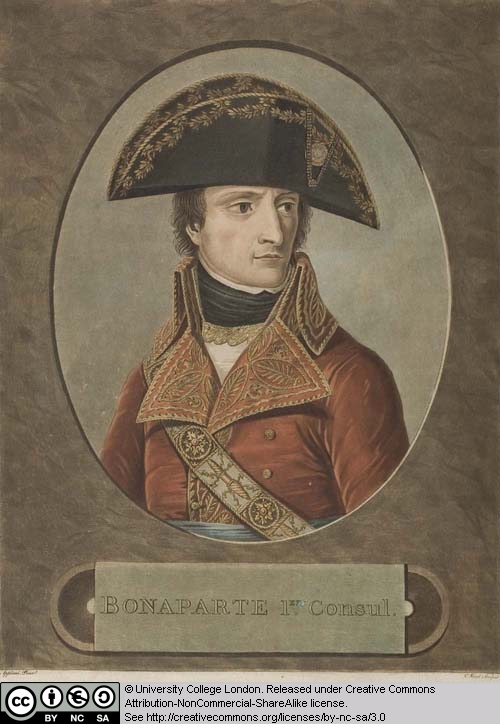24 Bonaparte

Jean-Baptiste Morret
(fl. 1790-1820) after Andrea Appiani (1754 – 1817)
1er Consul ,
c. 1800 – April 1804
Aquatint with
hand-colouring
Published by Drouhin,
Rue Hautefeuille, no.5, Paris
Andrea Appiani was chosen by Napoleon to be the official
painter of the Imperial court, so it is safe to assume that the painting from
which this print is derived, had its subject’s seal of approval. Appiani’s
depiction of the First Consul is as a dashing young general, resplendent in his
red velvet and gold brocade uniform. Alert and resolute, he looks to the left,
as if his attention has been caught by something in his line of view. This
characterises Napoleon as a quick-thinking , tactical military genius, whose
power and precision on the battlefield is evoked by the stylised thunderbolt
motifs on his sword strap: these are of a type that often feature in classical
representations of the god, Jupiter. A small tricolour cockade tucked into his
hatband acts as a reminder that, as First Consul, Napoleon upheld and extended
the legacy of the French Revolution and suggests that he will strike down the
enemies of the Republic.
The First Consul’s portrait is set into a trompe l’oeil marble
surround. Note the way that the artist has tried to suggest its three-dimensionality
through the use of shadow on the inside edge of the frame. It is as if we were
looking through a real marble frame into a different space, occupied by
Napoleon. The print, which is of a high quality and very sensitively coloured
by hand, would have found an eager audience. During the Consulat, Napoleon was
at the height of his popularity and there would have been a considerable demand
for depictions of him, particularly in his most popular guise as military hero.
Its high quality however, would have limited its distribution to those with at
least a moderate income.
Licensed under the Creative Commons Attribution Non-commercial Share Alike 3.0 License
This resource has been released as an open educational resource (OER) on a Creative Commons 'Attribution Non-commercial Share Alike' license. This means that once downloaded, content can be modified and improved to complement a particular course. This requires, however, that improvements are recycled back into the OER community. All content present at the time of download must be accordingly credited and, in turn, novel content must be appropriately licensed.